


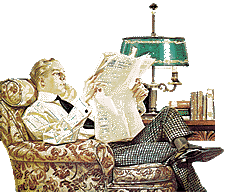

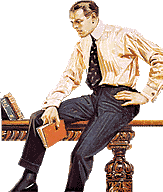 Even if he hadn't been a great artist, J.C. Leyendecker would have won awards for his marvelous signature.
Even if he hadn't been a great artist, J.C. Leyendecker would have won awards for his marvelous signature.
| Joseph Christian Leyendecker was born in 1874 in Germany and emigrated with his parents and younger brother, Frank, to America in 1882. He was part of the generation that included Franklin Booth (1874), Howard Chandler Christy (1873), James Montgomery Flagg (1877), F.R. Gruger (1871), Maxfield Parrish (1870), Frank Schoonover (1877), W.T. Benda (1873), Aubrey Beardsley (1872), Jessie M. King (1876), and W. Heath Robinson (1872). Like many of these artists, he developed a distinct, personal style and enjoyed a long, productive career. And like many of his contemporaries, he demonstrated early talent that was nurtured by his parents. In 1889 he completed what education he was to get. His family was unable to pay for further education in the arts, so Leyendecker apprenticed himself at the age of 15 to J. Manz & Co., a Chicago engraving house. He took art lessons in the evenings at the Chicago Art Institute. One of his primary instructors there was John H. Vanderpoel, whose books on anatomy are still being sought after today. Vanderpoel studied in France and brought the classical Academie techniques to his instruction. His efforts must have been effective, because Leyendecker quickly advanced from errand boy to staff illustrator at his day job. |
Issues 2, 4, 5, 11 & 12 feature Leyendecker artwork. 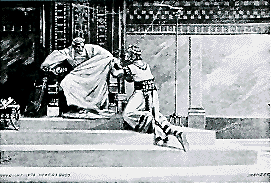 |
||
|
J. Manz & Co. was a printing house and at that time printing
houses provided more than reproduction services. Leyendecker
was called upon to design posters and advertisements for Manz
clients. At the age of 19, he was given the task of creating
60 illustrations for an edition of the Bible that Manz was to
produce. I've never seen a copy. From the few images that were
reproduced in Michael Schau's book, J.C. Leyendecker,
the source of the image above right, Leyendecker was one hell
of a precocious 19-year-old.
In 1896, he won a Century Magazine cover competition (2nd place was Maxfield Parrish!) that brought his work to national notice. (His winning entry is at right.) This led to cover assignments to other national magazines, like Inland Printer for whom he did all twelve of their covers for 1897. The work was produced, however, from Paris. Joe and his brother Frank, also a very talented artist, traveled to France in the Autumn of 1896. There, the brothers studied in the famous Academie Julian and Colarossi. The Leyendeckers were considered the most talented members of their class, and Joe even had a one-man show of his work at the smaller of the two major Salons - The Champs du Mars. [The Leyendecker name is curiously absent from the lists found in Lois Marie Fink's American Art at the Nineteenth-Century Paris Salons.] The brothers returned to America in the Fall of 1898 and opened a studio in Chicago. |
 Century Aug. 1896 |
||
 Joseph
soon was working for national publications like Colliers
and The Saturday Evening Post and in 1900 the Chicago
studio was exchanged for one in New York, the hub of the magazine
industry. From there he poured forth an amazing quantity of illustrations,
covers and advertisements. The new ability to reproduce color
illustrations was taking the magazine industry by storm and they
competed strongly for works that merited the expense. Leyendecker
was what we'd call today a "hot property" as his paintings
sold magazines and books, and publishers wanted more than just
a cover. Joseph
soon was working for national publications like Colliers
and The Saturday Evening Post and in 1900 the Chicago
studio was exchanged for one in New York, the hub of the magazine
industry. From there he poured forth an amazing quantity of illustrations,
covers and advertisements. The new ability to reproduce color
illustrations was taking the magazine industry by storm and they
competed strongly for works that merited the expense. Leyendecker
was what we'd call today a "hot property" as his paintings
sold magazines and books, and publishers wanted more than just
a cover.
There are only a handful of books illustrated by JCL, as the cover assignments traditionally paid better and required little if any more effort. His first book illustrations were in 1895 for The Dolly Dialogues and One Fair Daughter. Next came The Pit: The Epic of the Wheat in 1903, Ridolfo in 1906, Iole and Mortmain in 1907, and The Crimson Conquest in 1908. |
The Death of Eve from Century, Dec. 1906 |
||
| Putting a color illustration inside a magazine was a logistical nightmare. Color demanded special paper and printing care. Issues of magazines were practically designed around the color plates, which had to be collated between signatures or else individually glued in! One magazine, Delineator, came up with an idea: a feature comprised of a half dozen color plates that integrated text and art. By moving the text into the illustration, Delineator could insert this group between two signatures. Inserting the plates as a group incurred no more binding expense than if one sheet was inserted (it was done by hand). Other magazines quickly followed with similar color sections. | |||
 In 1905 he began a relationship with Arrow Collars
(later Arrow Shirts) for whom he created just one
of the icons he introduced into American psyche. The Arrow Collar
Man was the counterpoint of The Gibson Girl and was one of the
most successful advertising images in history. It turned Arrow
into the largest collar/shirt brand in America. He provided the
bulk of their advertising until 1930. Girls swooned over the
images of handsome young men, all painted from models who each
received mountains of fan mail each time a new face appeared
in the ads. The first model Leyendecker used was Charles Beach
(see sidebar).
In 1905 he began a relationship with Arrow Collars
(later Arrow Shirts) for whom he created just one
of the icons he introduced into American psyche. The Arrow Collar
Man was the counterpoint of The Gibson Girl and was one of the
most successful advertising images in history. It turned Arrow
into the largest collar/shirt brand in America. He provided the
bulk of their advertising until 1930. Girls swooned over the
images of handsome young men, all painted from models who each
received mountains of fan mail each time a new face appeared
in the ads. The first model Leyendecker used was Charles Beach
(see sidebar). |
It's not explicitly mentioned in Schau's biography, but Leyendecker was undoubtedly gay. He met Charles Beach in 1901 and lived with him for fifty years. Beach was originally a model but soon became Leyendecker's manager and assistant. Leyendecker pulled an effective veil over his private life and it's significant that by 1974 when Schau wrote his book, he could only fill 22 pages with words and nearly half of them are devoted to Leyendecker's life before he moved to New York. The people with whom he was closest were his brother Frank, his sister Augusta, and Beach, and they did not provide any written insights into his life. Still, there is much to suggest that he was. This means little to an appreciation of his talent, but does give the occasional insight to some of his images. | ||
|
In his heyday, Leyendecker was the most famous Post
cover artist they have ever had. His first cover for the magazine
was in 1899, before the cover became a miniature poster designed
to attract the eye of a newsstand buyer. He returned in 1903
for a 40-year association in which he produced over 320 covers.
His covers for the first issue of 1906 featured a winged cherub
that was the predecessor of the "New Year's Baby" -
a concept that still holds today. Each year, Leyendecker would
do the "important" Post holiday covers: Easter,
Thanksgiving, Fourth of July, Christmas, and New Years. I could
reproduce a dozen of them here and you'd still only get a hint
of how effective he was at producing that eye-catching image.
Here are two: at right top from December 18, 1909 and right bottom
from January 4, 1941 (The Post went to full-color covers
in 1926).
Other clothing manufacturers and magazines vied for his work and he prospered. He built a large house in New Rochelle in 1914. WWI found him working on war posters with a distinguished group that included Gibson, Christy, Flagg and Wyeth. After the war, if anything, he was more successful. He had a split with his brother Frank in the early 20's. No one seems to know what it was about, but Frank left the New Rochelle home where Joe had built him a wing for his private use. He reportedly died of an overdose in early 1924.
Leyendecker's art was always immediately recognizable after 1905. He developed a distinctive brush technique and a unique use of highlights within shadows. Some of his originals appear almost unfinished because he let the underpainting show through to represent the brightest highlights. This intriguing technique was to have an unlikely echo when groups of Filipino comic book artists in the 1960's would adopt the approach. I have a painting by Alfredo Alcala that pays homage to Leyendecker with this brush technique. |

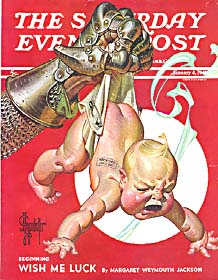 |
||
|
In 1943, the editorship of the Post changed and the
new editor felt that Leyendecker was too strongly associated
with the "old" magazine. So goes 40 years of a mutually
satisfying relationship. Joe had to go looking for work. He found
it, but not in the quantity he was used to. He maintained his
palatial home in New Rochelle, but had to let the servants go.
Alas, alas.
Some of the new commissions were war posters featuring the commanding officers of the U.S. forces encouraging the purchase of war bonds. The American Weekly hired him in 1945 to do covers. A Sunday supplement to the Hearst newspaper chain, the Weekly was printed on newsprint. The quality of the reproduction was nothing like Leyendecker had been used to and it must have rankled him. The effort he put into the paintings showed some of his frustrations. Many were recycled Post covers with minor changes. In 1951, while working on yet another American Weekly cover, Leyendecker had a heart attack and died. His sister and Beach had a yard sale of his canvases (and there were many as he tried to always insist on the return of his originals). $75 would have purchased any of the Post covers. sigh... |
|||
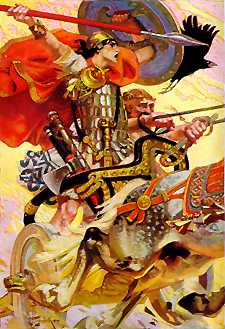 |
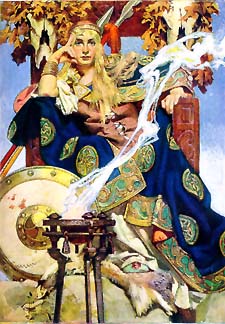
|
Some samples of illustrations
|
|
|
The Ancient Irish Sagas by Theodore Roosevelt in The Century, Jan. 1907 |
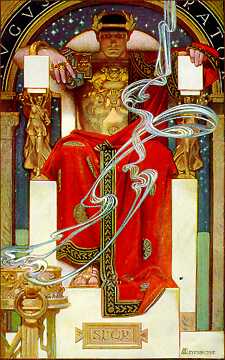
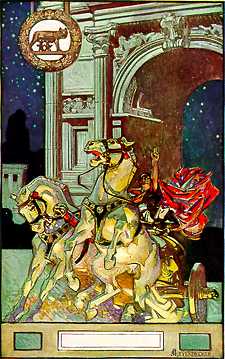
|
two of four plates for A Christmas Hymn by Alfred Domett in The Century, Dec. 1905 |

|
one of two color images for The Lucky Bag, the 1921 year book of the U.S. Naval Academy |
 To learn more about J.C. Leyendecker, see:
To learn more about J.C. Leyendecker, see:
| J.C. Leyendecker | Michael Schau, 1974 Watson-Guptill |
| 200 Years of American Illustration | Henry C. Pitz, Random House 1977 |
| The J.C. Leyendecker Collection | Kent Steine, 1995 Collectors Press |
| J.C. Leyendecker | Laurence & Judy Cutler, 2008 Abrams |
| The Vadeboncoeur Collection of Knowledge | Jim Vadeboncoeur, Jr. 1998 |
| The Vadeboncoeur Collection of ImageS 2, 4, 5, 11, 12 | Jim Vadeboncoeur, Jr. 2001-03, 2009, 2010, JVJ Publishing |
|
Illustrations are copyright by their respective owners. This page written, designed & © 1999 by Jim Vadeboncoeur, Jr. Updated 2011. |
